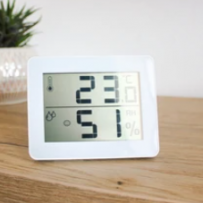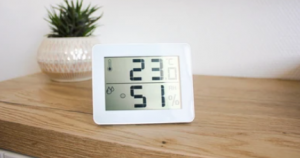Should I Use a Humidifier in the Winter if I Have Wood Furniture?

During the winter, the air is dryer than in other seasons as the humidity level drops along with the temperature. This means that the air in your home is dry in the winter months and as you run your heat, this will make the air even dryer. Heating your home creates a more comfortable temperature to combat the harsh winter weather, but it also sucks moisture out of the indoor air. Low moisture levels can cause problems in your home, especially for your wooden furniture.
Wood is a natural material that is affected by humidity. It will absorb moisture if exposed to water or high humidity levels in the air and it will lose moisture if the air around it is dry. Therefore, it is best for wood furniture to be in an environment with the right humidity level to avoid drying out or swelling with too much moisture. In order to balance the humidity level in your home this winter, you should consider using a humidifier, but it’s also important to understand how different types of wood react to moisture levels.
In this guide, we will discuss how humidity levels affect different types of wood as well as how to protect your wood furniture from getting too dry in the winter. The information presented here will help you decide if getting a humidifier for your home is a good idea. If your wood furniture is damaged due to excess moisture or lack thereof, contact our professionals for wood furniture repair and restoration.
How Does Wood Furniture Respond to Humidity?
Wood is an absorbent material and hydroscopic in nature, meaning it will lose or absorb moisture to find a balance with the airborne humidity level. When wood absorbs moisture, it swells and expands and when wood loses moisture, it will shrink and contract. Conditions that are too wet or too dry can result in structural damage to wood furniture.
- Too much moisture: Wood furniture and other wood surfaces absorb moisture from the air and from direct contact. Finishes on wood surfaces including wood stains, sealers, and toners will provide some protection against moisture absorption, but it will not protect the wood entirely from absorbing moisture. Wood that absorbs moisture will expand and if it holds this moisture for an extended period, it may not regain its original shape. Mold growth and rotting can also occur if wood has absorbed too much moisture.
- Too dry: In dry conditions, wood will lose some of its moisture and shrink or contract. This can cause cracks and gaps at furniture joints which can weaken the furniture.
How Humidity Affects Different Types of Wood
High humidity typically does not affect a piece of wooden furniture evenly, and different types of woods react differently to excess moisture. Denser woods tend to be more resilient to moisture while light woods are more likely to experience issues. Understanding how these common woods react to moisture will help you better protect your wood furniture:
- Mahogany: Mahogany is a dense wood with high resistance to moisture which means that it is less likely to warp, swell, or shrink. This is also one of the reasons why mahogany furniture tends to be expensive.
- Walnut: Walnut wood is also quite resistant to moisture and is less likely to warp or shrink with changes in humidity.
- Maple: Maple wood is finely textured and not the most moisture resistant type of wood. Wood flooring and furniture exposed to moisture will experience some damage.
- Oak: Oak is a moisture resistant wood that is less likely to absorb excess moisture and experience swelling and warping.
- Cherry: Cherry wood is close grained which makes it moisture resistant and less likely to shrink and warp.
- Pine: Pine is quite moisture resistant for a softwood and can resist swelling, warping, and shrinking.
- Teak: Teak is one of the most moisture resistant woods and can resist rotting, warping, cracking, and decay.
- Spruce: Spruce can resist rot and decay from moisture, but dryness may cause it to shrink.
- Cedar: Cedar is vulnerable to some expansion from moist conditions as well as some shrinkage from dry conditions. However, it is resistant to rotting and mold.
Protecting Wood Furniture from Changes in Humidity
During the winter months, it is important to control the humidity level in your home as cold weather combined with heating can cause a big drop in humidity. Heating systems suck the moisture out of the air as they run, and they will also remove the moisture from wood furniture. If wood furniture becomes too dry, cracking or spitting may occur, and this type of damage may be difficult or impossible to fix.
There are a couple of easy things you can to do prevent your wood furniture from becoming too dry. One way you can protect your furniture is to keep it out of direct sunlight as sunlight can suck the moisture out of the wood. You can also polish your wood furniture with a wood polish at the beginning of the winter to provide a little extra protection and help retain moisture. However, the most effective way to protect your wood furniture from a loss of moisture is with a humidifier.
Benefits of a Humidifier
Using a humidifier in the winter can benefit your home in several ways as it can create a more comfortable environment and prevent health issues such as sore throat and dry skin that can occur in dry environments. Humidifiers can also help you regulate the moisture level in your home which is better for your wood furniture and floors.
Keeping the humidity at a good level through the winter will help balance the moisture within the wood of your floors and furniture. This will prevent the wood from contracting, cracking, and splitting from becoming too dry. However, you also have to be careful not to let the humidity level get too high or you put your wood furniture and floors at risk of swelling, warping, or rotting. It is recommended that you keep the humidity level of your home between 30 and 50 percent.
Wood Furniture Refinishing and Repair from Furniture Medic by MasterCare Experts
The Chicago area is in for some cold, dry weather over the next couple of months. You can help protect your wood furniture from the dryness by investing in a humidifier to regulate the moisture level of your home.
At Furniture Medic by MasterCare Experts, we can also help you protect your furniture with our wood furniture refinishing and repair services. We can refinish old or worn-out wood furniture to revitalize its appearance or provide a protective finish to improve the moisture resistance of your furniture. If your furniture becomes cracked or split from the dry conditions, we can repair the damage and we can also dry and repair wood furniture affected by water damage.
You can call Furniture Medic by MasterCare Experts at (630) 653-3131 or Submit Your Project through our website.



